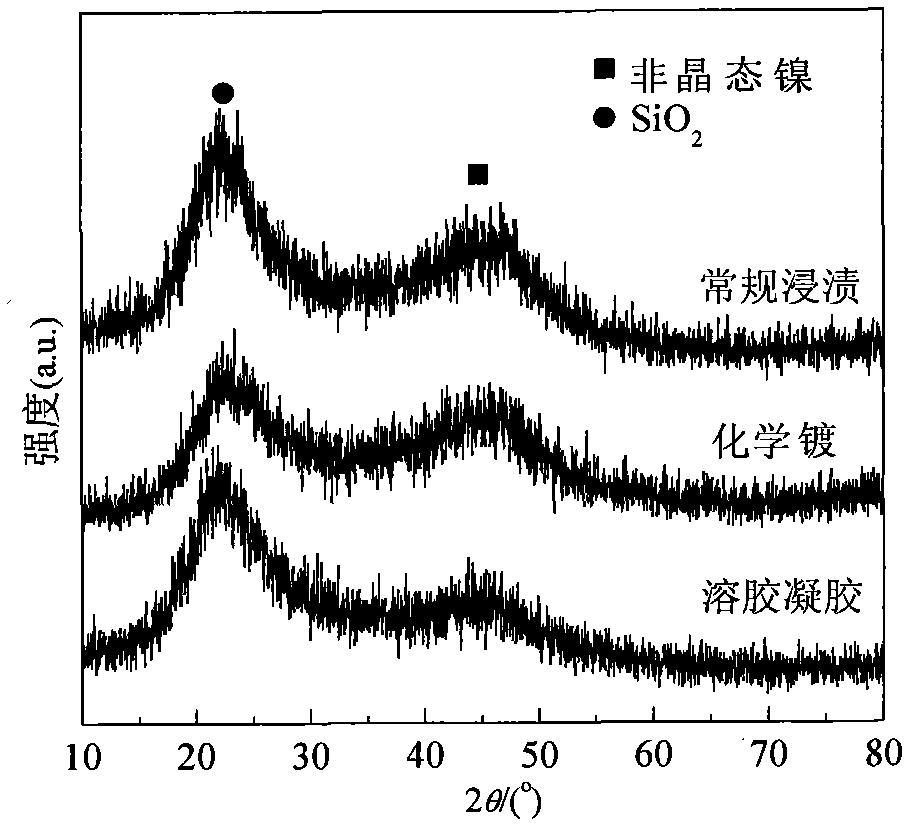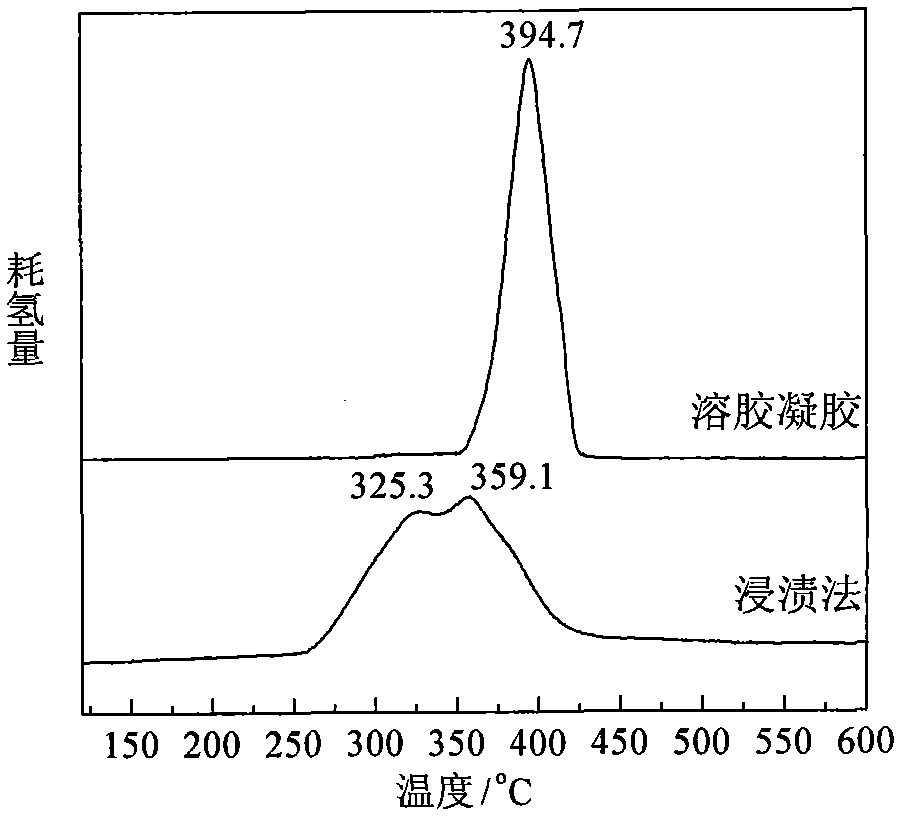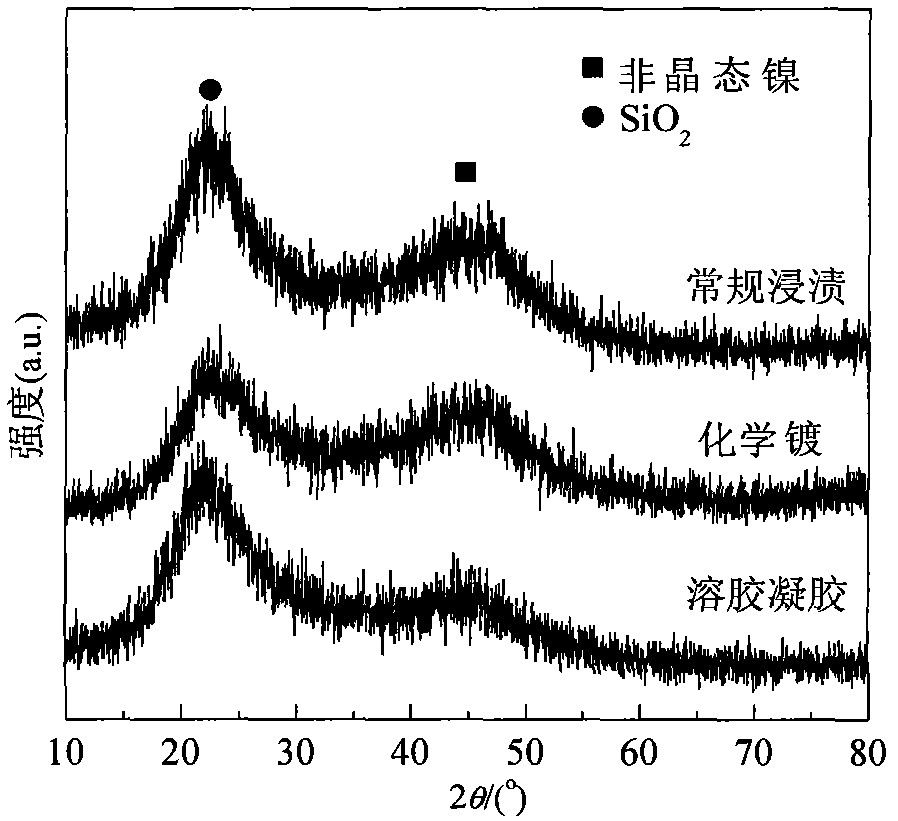Amorphous alloy catalyst for hydrogenating dinitrotoluene and application of amorphous alloy catalyst
A technology of dinitrotoluene and amorphous alloys, which is applied in the field of preparation of supported Ni-B amorphous alloy hydrogenation catalysts, can solve problems affecting catalyst hydrogenation performance, achieve low price, strong interaction, The effect of good hydrogenation performance
- Summary
- Abstract
- Description
- Claims
- Application Information
AI Technical Summary
Problems solved by technology
Method used
Image
Examples
Embodiment 1
[0035] (1) 20ml concentration is 0.6mol / L Ni(CH 3 COO) 2 4H 2Add the aqueous solution of O dropwise to 40ml of ethanol solution with a concentration of 1.5mol / L ethyl orthosilicate, and add 1ml of acetic acid at the same time, place the mixed solution in a water bath at 60°C, and slowly stir until it gels.
[0036] (2) Put the gel in an oven and dry it at 110°C for 11h, then grind the gel to below 200 mesh, and then bake it in a muffle furnace at 500°C for 5h to obtain NiO / SiO 2 Prebody.
[0037] (3) Put 1mol / L KBH in an ice-water bath 4 Solution, KBH is passed through 2.0mol / L NaOH solution 4 The pH of the solution was adjusted to 7 by KBH 4 / Ni=4 (molar ratio), add dropwise to the calcined NiO / SiO at a rate of 3ml / min 2 In, after the dropwise addition, continue to stir until no bubbles are produced, wash with distilled water to neutrality, and then wash with ethanol for 5 times, and the obtained composition is Ni-13.7wt%, B-15.5wt%, SiO 2 -70.8wt% catalyst, and keep i...
Embodiment 2
[0041] (1) Make 15ml concentration of 1mol / L NiCl 2 The aqueous solution was added dropwise to 80ml of ethanol solution with a concentration of 1.3mol / L ethyl orthosilicate, and 2ml of acetic acid was added at the same time, the mixed solution was placed in a 60°C water bath, and slowly stirred until it gelled.
[0042] (2) Dry the gel in an oven at 110°C for 9 hours, then grind the gel to below 200 mesh, and then bake it in a muffle furnace at 550°C for 6 hours to obtain NiO / SiO 2 Prebody.
[0043] (3) Add 1.2mol / L of KBH in an ice-water bath 4 Solution, KBH is passed through 2.0mol / L NaOH solution 4 The pH of the solution was adjusted to 7 by KBH 4 / Ni=4 (molar ratio), dropwise added to the calcined NiO / SiO at a rate of 4ml / min 2 In, after the dropwise addition, continue to stir until no bubbles are produced, wash with distilled water to neutrality, and then wash with ethanol for 3 times to obtain the composition of Ni-10.2wt%, B-11.5wt%, SiO 2 -78.3wt% of the catalyst ...
Embodiment 3
[0046] (1) 10ml concentration is 0.7mol / L Ni(NO 3 ) 2 The aqueous solution of the solution was added dropwise to 70ml of ethanol solution with a concentration of 1.3mol / L ethyl orthosilicate, and 3ml of acetic acid was added at the same time, the mixture was placed in a 60°C water bath, and slowly stirred until it gelled.
[0047] (2) Dry the gel in an oven at 110°C for 15 hours, then grind the gel to below 200 mesh, and then bake it in a muffle furnace at 450°C for 7 hours to obtain NiO / SiO 2 Prebody.
[0048] (3) Add 1.2mol / L of KBH in an ice-water bath 4 Solution, KBH is passed through 2.0mol / L NaOH solution 4 The pH of the solution was adjusted to 7 by KBH 4 / Ni=3 (molar ratio), dropwise added to the calcined NiO / SiO at a rate of 4ml / min 2 In, after the dropwise addition, continue to stir until no bubbles are produced, first wash with distilled water to neutrality, then wash with ethanol for 4 times and then wash with ethanol for 3 times, the obtained composition is N...
PUM
 Login to View More
Login to View More Abstract
Description
Claims
Application Information
 Login to View More
Login to View More - R&D
- Intellectual Property
- Life Sciences
- Materials
- Tech Scout
- Unparalleled Data Quality
- Higher Quality Content
- 60% Fewer Hallucinations
Browse by: Latest US Patents, China's latest patents, Technical Efficacy Thesaurus, Application Domain, Technology Topic, Popular Technical Reports.
© 2025 PatSnap. All rights reserved.Legal|Privacy policy|Modern Slavery Act Transparency Statement|Sitemap|About US| Contact US: help@patsnap.com



